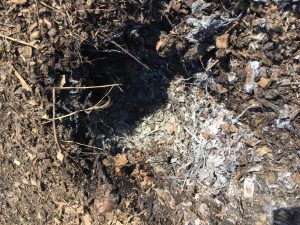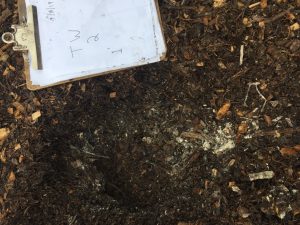Final report for FNE16-855
Project Information
The purpose of this project was to determine whether a low-cost Aerated Static Pile (ASP) system would improve the operational efficiency of our farm-based composting program at Kindgom View Compost (KVC).
At KVC, our goal is to compost food scraps from our local area, thereby recycling this nutrient-rich resource and producing a valuable soil amendment. The composting method we have used at KVC since 2005 is a typical turned windrow system. It is a commonly used method, which involves building long compost piles (windrows), and turning the windrows several times with a tractor bucket to create aerobic conditions conducive to thermophilic composting. The ASP system we built and used for the trial is designed to save time, space, and labor compared to the turned windrow system by creating optimal aerobic conditions without turning the piles with a tractor. This is achieved by forcing air into the pile from beneath, using a system of a fan, ductwork and woodchips.
We performed side by side composting trials in the summer of 2019 and attempted to measure differences in: time required to meet the time/temperature requirements as defined by the National Organic Program, area/ square footage required to produce the same volume of compost with the two different systems, and labor hours required for each system. We also attempted to assess any evident differences in compost quality throughout the composting process which might indicate a more effective decomposition process.
We found that the ASP system did indeed save composting time in general, although with some mixed results due to data collection setbacks. We found that we were able to produce compost with our ASP system using about ⅓ of the area required by our turned windrow method. We were unable to glean any conclusive results on labor-time saved by the ASP system, but again we believe that with more trialling and better data collection that the ASP system would prove to be a labor saver. Visual and odor observations seemed to indicate more rapid decomposition of food scraps in the ASP system than in the turned windrow system.
Outreach of our findings went to farmers and composters via online networks provided by UVM Extension's Chris Callahan, Agricultural Engineer. We also shared the results and link to report to NOFA-VT and Farm to Table, the latter published the results in one of their emissions in 2020.
In Vermont’s Northeast Kingdom, the “Close the Loop” food scrap composting program has grown tremendously in popularity and continues to do so. We need to grow in order to continue to be a model organics recycling system for other communities / municipalities / farms to follow. We have now reached the point of being challenged to continue to accept the volume of food waste generated by Close the Loop. As a small farm, land and time are extremely valuable to us and we work hard to reduce waste throughout our operations. Currently, we provide oxygen to our compost windrows by turning them with a tractor, but this is a labor-intensive process and only provides an ideal amount of oxygen for a brief window (20-60 minutes).
Like many farms, it is a challenge for us to meet the time/temperature requirements as defined by the National Organic Program. The Aerated Static Pile (ASP) composting system we built and tested provides oxygen by pushing air through the compost with a timer controlled fan and aeration manifold beneath the compost. Meeting the temperature requirements in our permits and for use on organic farms will only take 3 days at 131 F using an ASP system. Most importantly, we think that this ASP system is affordable compared with other systems, and will allow us to produce compost more efficiently, without increasing the footprint of our present composting facility. Our primary objective in this research trial is to compare the speed and efficiency of the ASP to our conventional turned windrow methods. If it is indeed a significantly more efficient system, our composting operation will save time and money. In light of Vermont's universal recycling law, and increasing farm composting throughout the Northeast, future farm composters will benefit as well.
The farm has looked at several ASP systems and found the costs to be prohibitive. We have identified a system design that could aerate just under 100 cubic yards, which is our weekly target at permitted capacity. The pilot system cost approximately $1000 in materials, which is about 1/10th the cost of other systems we’ve looked at.
We wish to measure the time it takes to produce finished compost using the ASP system to our conventional methods of composting. We also wish to measure the costs involved. With less pile rolling using the ASP, we believe that tractor time, fuel, wear and tear, and labor will be saved, but how much? How much money can be saved per cubic yard of compost produced in a year's time? How much more compost can be produced using ASP compared to our current method, on the same size facility? Is compost produced using ASP superior to turned windrow compost, inferior or comparable?
We will be sharing any lessons learned from our composting trials with other composters and farmers via online networks.
Cooperators
Research
During the Summer months of 2019, Kingdom View Compost (KVC) built four research compost piles- two piles which were composted using our farm-built ASP system, and two piles which were composted using our normal Turned Windrow system.
The practical differences between our turned windrow piles and our ASP piles are mostly in the way that they are constructed and operated: The feedstock materials are the same, and are blended the same way in order to produce a starting compost mix.
Our turned windrows are built with our tractor by placing bucket-loads in a windrow formation, about 5-6’ high, and approximately 12’ wide. The compost material is deposited directly on our impermeable composting pad surface. Following that it is turned with a tractor bucket along its length to maintain a sufficiently aerobic environment for thermophilic composting.
In contrast to this system, we build our ASP pile on a 8” high bed of wood chips, in which is buried 2 full-length perforated PVC pipes of 4” diameter. An electric blower fan supplies air to the ASP, via ducting, a distribution manifold, and the woodchip distribution plenum. See attached file "ASP Design and Budget" for details of materials and construction. Care is taken not to drive on the pipes when building the piles in order to minimize potential damage to the system. The pile is built from the sides for this reason, but can also be built front-to-back if the tractor operator can avoid the pipes by driving between them.
All piles were blended using the same feedstock materials- 50% wood chips, 25% food scraps, and 25% dairy manure/bedding. In order to allow adequate time for composting, the first ASP pile was built with the goal of an 8-week residency in the ASP system. The first turned windrow pile (TW1) was built in the following two weeks, and then managed by turning approximately weekly for 1 month. Following this, the next side by-side ASP and turned piles were constructed and monitored. The summer trials lasted from May 1 – Sept 9, 2019.
For the purposes of analyzing the efficiency of the ASP system relative to the current turned windrow system, we set out to measure the following:
- Time required for compost to meet the time/temperature requirements as defined by the National Organic Program, as well as the difference in time required for compost to finish active composting and begin curing.
- Space used to manage the compost piles, measured as square ft. per cubic yard.
- Labor inputs required to produce compost in both types of systems, measured in both person-hours and tractor hours.
- Differences in quality of finished compost between the two types of composting systems. Compost quality was assessed by observing the stage of decomposition of the side-by-side piles, as well as smells, moisture content, etc. These observations were recorded in monitoring notes, and through photo documentation. We had originally planned to send samples of the finished compost for nutrient analysis, but by this stage in our process, the project budget no longer allowed for lab testing
A) Does using an ASP system make compost in less time than a Turned Windrow System?
The information we used to answer this question included:
Number of days from when a pile was started to when the pile met the time/temperature requirements as defined by the National Organic Program. In the case of the ASP system, this requires the compost to maintain “a temperature of between 131 °F and 170 °F for 3 days”. . In the case of turned windrow compost, the pile is required to maintain “a temperature of between 131 °F and 170 °F for 15 days (using a windrow composting system), during which period, the materials must be turned a minimum of five times.”
Based on our monitoring of the piles, we were able to answer this question somewhat, however with limited success. The attached graphs display the temperature monitoring which we were able to capture with the data loggers we used.
First Treatment Round
Pile ASP1 was monitored with Data loggers labeled B1 and B2. As indicated by the attached graph labeled “ASP1 Temp Graph B1”, our logger only captured about a week of activity- the logger needed to be reset on 5/17 when we discovered that the memory storage was full. After a week of successful monitoring, logger B1 appears to have stopped recording temperatures. Indicated by the temperatures captured in the attached graph “ASP1 Temp Graph B2”, our logger B2 appears to have captured the same dates.
Temperature Graph- Pile ASP1 _ Logger B1
Temperature Graph - Pile ASP1 _ Logger B2
Temperature Graph - Pile TW1 _ Logger A3
Although the entirety of temperatures during the ASP process was not captured by our loggers, the two graphs for this pile show that the piles met heat treatment requirements very quickly- in this case between 5/17 and 5/20. Looking at the graphs, it appears likely that pile ASP1 met its treatment temps even earlier than this.
The first turned windrow pile (TW1), on the other hand, indicates more challenges in meeting temperature treatment standards quickly for a number of reasons. Both loggers A2 and A3 show that there was potential to meet the more stringent treatment standards for a turned windrow mentioned above, yet the pile did not consistently heat- and where the material did heat, the 1x/week turning schedule followed by the farm did not meet NOP requirements. It is unclear why Logger A3 Sensor 1 showed material that did not consistently heat. Possible reasons for this might be an unusually compacted spot in the pile, or possibly that the probe sensor was placed too close to the outside layer of the pile, the material in which will be closer to ambient temperatures than the interior of the pile.
When TW1 was turned on 5/27, the temperatures spiked following the turning. However, they did not consistently spike to temperatures above 131 in all areas of the pile. As indicated in the attached Graph labeled “TW1 Temp Graph A2”, the compost was in a heating trend following its 5/26 turning, but would have benefited from another turning by 5/30, in order to aerate the compost before it cooled below 131 on 5/31.
The other logger (A3) in pile TW1, indicates that even following the 5/26 turning, some of the pile’s material remained below PFRP temperature. It isn’t until 5/31 that the temperatures on both sensors of Logger A3 show a dramatic increase, above PFRP. Unfortunately, Logger A3 stopped recording at this point.
Second Treatment Round
In the second round of treatments, similar results were noticed. By this point in the project, only one data logger was still functioning (A2). We placed A2 in pile ASP2, where it monitored temperatures for the duration of the pile treatment. As indicated in the attached ASP Temp Graph A2, the three-day heat temperature requirements were met very early in the treatment, between 6/30 and 7/3.
Temperature Graph - Pile ASP2 _ Logger A2 Graph
Temperature Graph - Pile TW2_ Manual Monitoring
Following this, the graph shows a dramatic drop in temperature followed by a daily pattern of heating and cooling. We believe this is because logger A2 was accidentally removed from the pile, and either placed on the very edge of the pile, or in the metal shed that houses the ASP fan system. It is assumed that the logger was replaced in pile ASP2 on 7/23, as evidenced by the spike back to thermophilic temperatures. Had the logger remained in the pile during this period, the graph would likely show that temps generally remained well above 131 degrees for those three weeks.
The second turned windrow treatment (TW2) appears from the graph to have remained at temperatures above 131F from 7/28 through the duration of the treatment, ending on 9/8. Due to a lack of functioning data loggers, the pile temperatures were monitored manually five times during the treatment, and the pile was turned once, on 8/11. The demands of the farm crops, both hay and hemp, made it difficult to monitor or turn more frequently than this.
Once again, the ASP pile was able to meet its treatment targets requirements quickly. The turned windrow pile also appears to have stayed at temps above 131 F for most of the treatment. But the pile still was unable to meet its required number of turnings, and therefore would not meet NOP requirements for compost.
Observational Analysis
We also used observational analysis to judge whether either system was producing compost faster. When monitoring the piles, we dug into them in order to assess the relative state of decomposition of the “problem feedstock”, in this case food scraps. We used visual assessment and the “smell test” to judge progress of active decomposition, as well as monitoring the moisture content, another critical factor in the composting process which can be affected by excessive aeration.
It appeared from observation that in both sets of treatments, the material in ASP piles had decomposed more than the material in the turned windrows given the same amount of time composting. Observations included smaller particle size of wood chips (the primary bulking agent in the compost recipe), less visible evidence of food scraps in the pile, and a slightly less sour smell, which is associated with freshly composting food scraps.
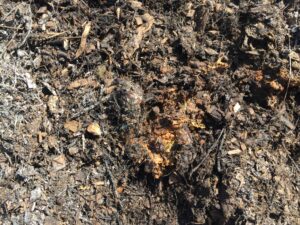 TW1 June 17 (visible food scraps)
TW1 June 17 (visible food scraps)
Conclusions
Based on the temperatures that we were able to record, as well as our own sensory observations, we believe that our pilot ASP system does indeed make compost faster than a turned windrow system as implemented at Kingdom View Compost.
This is attributable to the highly aerobic environment in the compost pile created by an ASP system. The available oxygen to meet the biological oxygen demand (BOD) in a turned windrow compost pile begins to deplete in a matter of hours after a turning. In a properly sized ASP system with correct fan settings, the oxygen demand is met more consistently by the forced air from the fan. The higher temperatures in the ASP piles indicate greater aerobic microbial activity, which may be attributed to the replenished oxygen from the ASP.
- B) Does an ASP system make compost using less space than a turned windrow?
Land is a precious asset at Tamarlane Farm, and it is a goal on the farm to operate and expand Kingdom View Compost while retaining as much land as possible for livestock and crops. Therefore part of the reason to pilot the ASP system is to see whether we can produce as much compost or more than we currently do, while using a smaller footprint.
Based on the attached spreadsheet “B) Area/Pile”, it is clear that an ASP system does indeed require less area per yard of compost produced. The reason for this is that while both piles need a certain area footprint for the pile, and for tractor access to the pile to stack it and then move it elsewhere, the turned windrow system requires space on either side of the windrow for the tractor to efficiently turn the pile with a loader bucket the minimum five times to meet the temperature treatment requirements. The tractor needs space at least it’s own length along the side of the entire pile to approach the pile, “roll” the pile, and then back up and reposition to continue turning the windrow.
In a typical turned windrow composting system, the pile is rolled continually in the same direction, and space is thereby made for the next pile once the first pile has been rolled far enough along the pad. Therefore an equal amount of space is required on the other side of a windrow, both for a place to roll the compost, and because the tractor will need that space to turn the previous windrow, which has been gradually turned/moved along.
It is also typical to provide pad space on either end of a turned windrow, in order for the tractor to have access to roll and shape up the ends of the windrow which often get scattered and lose volume during the turning process.
In contrast to this system, an ASP pile is not moved during the initial composting phase, which is typically 3-4 weeks. Therefore the tractor does not need space on both sides of the windrow’s length. Theoretically, in an ASP system the tractor only needs to approach the pile from one end to stack the material, and then to deconstruct the pile when it is time to move it from the ASP system. Regarding space required around the ends of a pile, one of the ends of an ASP pile is often “bookended” by either an air-delivery manifold system or a push-wall. Therefore the other “access” end is the only side of the pile for which the tractor requires the same amount of space as a turned windrow.
An ASP system does however have space requirements that the turned windrow system does not- it requires space for the fan system, manifold, and any other associated equipment. In the case of our low-cost pilot ASP system, the shed for the fan and associated equipment was designed to be compact, taking up little space.
As shown in the attached spreadsheet “B) Area/Pile”, we estimate that Kingdom View Compost’s low-cost pilot ASP system makes each cubic yard of compost using roughly ⅓ the area footprint of our turned windrows. This in turn translates to a savings in infrastructure costs of also roughly ⅓ , when calculating the cost of creating an improved, impermeable composting pad surface.
As KVC looks to the future and expanding its food scrap composting capacity, saving of space on the farm and savings of infrastructure costs make our pilot ASP system very attractive due to the smaller footprint it requires per yard of compost produced.
C) Does an ASP system make compost using less labor than a turned windrow system?
To answer this question, we simply attempted to record the number of labor hours spent on all operations per pile. These tasks included mixing/blending in the receiving bay, building the compost piles on the pad or on the ASP pipe system, monitoring the piles, and deconstructing the piles.
Unfortunately, the results from our labor analysis are inconclusive. As shown in the attached spreadsheet, the first treatment shows that ASP 1 required slightly less hours per yard than TW1, both in terms of person-labor-hours and tractor-hours. Hours recorded for the second treatment seem to show the opposite, with TW2 requiring less labor hours per yard of compost. Furthermore, if making an assessment based on the information shown, the difference in labor hours between the two composting systems would appear negligible, with the greatest difference shown between piles being 0.04 hours per yard, or 2.4 minutes.
In theory, an ASP system should save labor compared to a turned windrow system, because of the several turnings required for a turned windrow. In addition, the data we captured did not capture labor throughout the life of the pile, which should be less in the ASP assuming it reaches maturity faster and requires a shorter management period. Part of the reason the labor hours are not higher for our turned windrows (especially in the case of TW2) is because they were not turned as frequently as needed. This fact itself helps to demonstrate the value of an ASP composting system to KVC, since it is difficult to set aside time during the busy farming season to turn the piles as frequently as needed.
It should be noted however, that our pilot ASP system requires an additional labor task that our turned windrows do not- the air delivery system includes rigid air pipes buried in a “plenum” of wood chips (to evenly disperse the forced air). Each time a pile is started, time is taken to ensure an adequate amount of wood chips is evenly laid over the pipes. Care must be taken during both pile construction and deconstruction not to drive the tractor over and break the PVC pipes. The building and construction of a turned windrow should be faster in this regard.
D) Does an ASP system make compost of better quality than our turned windrow system?
We had initially planned to answer this questions at multiple stages throughout the life-cycles of the compost piles- from active thermophilic composting, to finished compost, and then curing piles. Quality of active thermophilic composting is difficult to assess, but by monitoring for temperature, moisture content, and performing both visual assessment for progress of decomposition and the smell test for healthy aerobic conditions, we attempted to get a general idea of how the composting process was progressing. The same observational analysis was performed later in the piles’ life-cycles as the compost matured.
Visual observation
In general, it appeared from visual observation that material in the ASP treatments was more decomposed than the material in the turned windrows when observed at roughly 5 weeks. Particle size of wood chips appeared smaller, and the ASP pile smelled active, but farther along in the composting process. There appeared to be more un-decomposed food scraps in the outer layer of TW1 than was found in ASP1.
Moisture
Throughout both treatments, there was no indication that anaerobic conditions were present in any pile. However, after one month of composting, both ASP piles showed evidence of drier-than-ideal moisture content, which would be detrimental to thorough decomposition. Ideal moisture content is around 60%, and some of the outer material in the ASP piles were observed to be at 50% or lower.
Actinomycetes
All piles appeared to have a healthy population of actinomycetes in the outer 12-15” of the piles, which is an indicator of active composting.
Temperature
From the recorded temperatures, it is difficult to say with certainty whether either composting system created better conditions for composting. In both ASP piles, temperatures were recorded that are considered higher than ideal for composting- for example, ASP2 was shown to have temperatures of 168F before the probe was removed for 3 weeks. Following that, the temperatures tapered off to the 140’s, a much better environment for thermophilic decomposers. The temperatures in ASP1 look better according to data logger B2- from the limited dates we captured, the compost showed temperatures consistently in the 140s. But data logger B1 showed ASP1 to have consistent temps in the 160s- again; higher than ideal. Excessively high temperatures run the risk of drying out the material, especially in an ASP system with forced aeration. Microbial diversity also drops considerably as temperatures increase above the 140s, so lower temperatures are a management goal in the system, although we have found that this is often hard to achieve.
Similar erratic temperature profiles were found in TW1- Logger A2 shows temps from Sensor #1 in the upper 150s and 160s, while Logger A3 Sensor #1 shows that some material never got above 100F.
It seems that from the limited information we captured, we cannot conclude that either system provides more ideal temperatures for active thermophilic composting.
Temperature Graph - Pile ASP1 _ Logger B2
Temperature Graph- Pile ASP1 _ Logger B1
Temperature Graph - Pile TW1 _ Logger A3
Temperature Graph - Pile TW2_ Manual Monitoring
Temperature Graph - Pile ASP2 _ Logger A2 Graph
Compost Maturity Testing and Lab Analysis
When we originally conceived of this on-farm research project, we intended to use Solvita testing kits to assess the maturity of the test piles. We also planned to send samples of the finished compost to a laboratory for nutrient analysis, in order to ascertain whether either system produced a compost of higher quality.
Due to time and budget constraints, we decided that these steps were impractical, and did not do either. Therefore at this time, we cannot say whether any of our test piles matured faster than others, or were of higher quality and nutrient value.
Education & Outreach Activities and Participation Summary
Participation Summary:
Outreach of our findings went to farmers and composters via online networks provided by UVM Extension's Chris Callahan, Agricultural Engineer (blog and social media push). We also shared the results and link to report to NOFA-VT and Farm to Table, the latter published the results in one of their emissions in 2020.
We believe we reached 50 to 100 farmers, at least, via social media.
Learning Outcomes
From our round of on-farm research conducted in Summer 2019, the most decisive lesson that we have been able to glean is that our Pilot ASP system allows us to meet the NOP’s heat treatment heat treatment standards in a much shorter time than with our current turned windrow system. This is mostly due to the highly aerobic environment created by forced aeration. It is also in part because the standards for the two systems have very different time requirements- 3 days for ASP systems with zero turnings compared to at least 15 days for turned windrow systems, during which the windrow must be turned at least 5 times.
While the ASP system is a clear advantage in this regard, another valuable lesson we learned is that the ASP system’s aeration schedule must be monitored more frequently and adjusted in order that the piles do not overheat or over-dry.
Another clear take-away from our trials is that our pilot system produces compost using much less area than our turned windrow system. In this regard it is also a clear winner for Kingdom View Compost, since it will allow for more production with lower infrastructure costs, and simultaneously will preserve more cropland should we continue to expand operations.
Project Outcomes
Our research should be valuable to the composting community in general, and especially in the state of Vermont.
As Act 148 is implemented it may become necessary for more composting operations to start up and become accessible. Because of our research new start up (or potentially start up) composting operations can operate on half of the amount of space as originally believed would be required compared to a conventionally turned windrow system. Twice the production in half of the space.
Following our 2019 research trials, there remain some unanswered questions- for example the question of whether an ASP system produces compost which matures faster, or compost of higher quality than that produced in a turned windrow system.
While our research proved inconclusive regarding the labor-savings of the pilot ASP system, we feel strongly that the ASP system is a labor-saver, if only for the fact that it allows us to produce compost without setting aside time for several turnings in a short window of time.
More work needs to go into perfecting our ASP system to manage ideal temperatures, moisture, and rate of composting and maturity. But in general, we have been happy with the performance of the Pilot ASP system, and plan to build out more ASP capacity should we decide to expand composting operations at Kingdom View Compost.
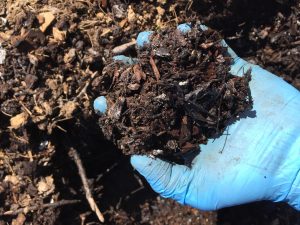 ASP 1 June 17
ASP 1 June 17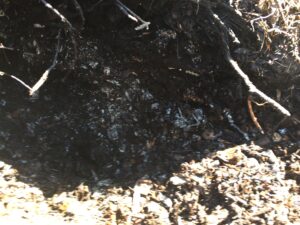 ASP1 June 17
ASP1 June 17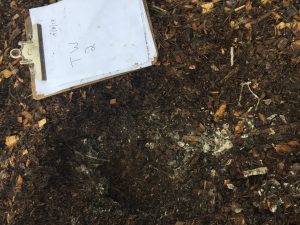 TW2 Sept 9
TW2 Sept 9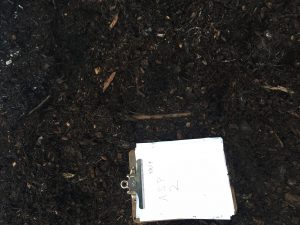 ASP2 Sept 9
ASP2 Sept 9